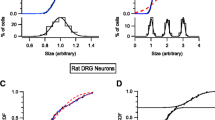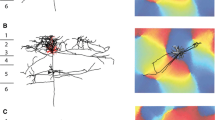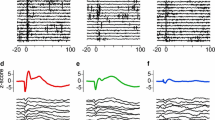Summary
The population of neurons in the cat motor cortex which receives monosynaptic input from a specific functional region of the somatic sensory cortex was identified with the techniques of intracellular recording and staining with HRP. Both pyramidal and nonpyramidal cells located in the superficial layers of the pericruciate cortex responded to stimulation of the sensory cortex with short latency, excitatory postsynaptic potentials. More than half of the labeled cells were classified as pyramidal cells and the remainder as sparsely spinous or aspinous nonpyramidal cells. The characteristics of the EPSP's of the 2 groups of cells, ie. latency, time from beginning to peak and amplitude were found to vary only slightly. The results suggest that input from the sensory cortex impinges upon neurons which may in turn have an excitatory or inhibitory effect on corticofugal neurons in the motor cortex.
Similar content being viewed by others
References
Asanuma H, Arissian K (1984) Experiments on functional role of peripheral input to motor cortex during voluntary movements in the monkey. J Neurophysiol 52:212–227
Asanuma H, Sakata H (1967) Functional organization of a cortical efferent system examined with focal depth stimulation in cats. J Neurophysiol 30:35–54
Feldman ML (1984) Morphology of the neocortical pyramidal neuron. Plenum Press, New York London, pp 123–200
Ghosh S, Porter R (1988) Corticocortical synaptic influences on morphologically identified pyramidal neurones in the motor cortex of the monkey. J Physiol 400:617–629
Herman D, Kang R, MacGillis M, Zarzecki P (1985) Responses of cat motor cortex neurons to cortico-cortical and somatosensory inputs. Exp Brain Res 57:598–604
Ichikawa M, Arissian K, Asanuma H (1985) Distribution of corticocortical and thalamocortical synapses on identified motor cortical neurons in the cat: Golgi, electron microscopic and degeneration study. Brain Res 345:87–101
Itoh K, Konishi A, Nomura S, Mizuno N, Nakamura Y, Sugimoto T (1979) Application of coupled oxidation reaction to electron microscopic demonstration of horseradish peroxidase: cobalt-glucose oxidase method. Brain Res 175:341–346
Iwamura Y, Tanaka M (1978) Functional organization of receptive fields in the cat somatosensory cortex. II. Second representation of the forepaw in the ansate region. Brain Res 151:61–72
Kosar E, Waters RS, Tsukahara N, Asanuma H (1985) Anatomical and physiological properties of the projection from the sensory cortex to the motor cortex in normal cats: the difference between corticocortical and thalamocortical projections. Brain Res 345:68–78
Nieoullon A, Rispal-Padel L (1976) Somatotopic localization in cat motor cortex. Brain Res 105:405–422
Oscarsson O, Rosen I (1966) Short-latency projections to the cat's cerebral cortex from skin and muscle afferents in the contralateral forelimb. J Physiol Lond 182:164–184
Peters A, Jones EG (1984) Classification of cortical neurons. In: Peters A, Jones EG (eds) Cerebral cortex, Vol 1. Plenum Press, New York London, pp 107–121
Peters A, Redigor J (1981) A reassessment of the forms of nonpyramidal neurons in area 17 of cat visual cortex. J Comp Neurol 203:685–716
Peters A, Saint Marie RL (1984) Smooth and sparsely spinous nonpyramidal cells forming local axonal plexuses. In: Peters A, Jones EG (eds) Cerebral cortex, Vol 1. Plenum Press, New York London, pp 419–445
Porter LL, Sakamoto K (1988) Organization and synaptic relationships of the projection from the primary sensory to the primary motor cortex in the cat. J Comp Neurol 271:387–396
Ramon-Moliner E (1961) The histology of the postcruciate gyrus in the cat. III. Further observations. J Comp Neurol 117:229–249
Sakamoto T, Arissian K, Asanuma H (1989) Functional role of the sensory cortex in learning motor skills in cat. Brain Res (in press)
Sakamoto T, Porter LL, Asanuma H (1987) Long-lasting potentiation of synaptic potentials in the motor cortex produced by stimulation of the sensory cortex in the cat: a basis of motor learning. Brain Res 413:360–364
Waters RS, Favorov O, Asanuma H (1982) Physiological properties and pattern of projection of cortico-cortical connections from the anterior bank of the ansate sulcus to the motor cortex, area 4y, in the cat. Exp Brain Res 46:403–412
Watt DGD, Stauffer EK, Taylor A, Reinking RM, Stuart DG (1976) Analysis of muscle receptor connections by spike-triggered averaging. I. Spindle primary and tendon organ afferents. J Neurophysiol 39:1375–1392
Author information
Authors and Affiliations
Rights and permissions
About this article
Cite this article
Porter, L.L., Sakamoto, T. & Asanuma, H. Morphological and physiological identification of neurons in the cat motor cortex which receive direct input from the somatic sensory cortex. Exp Brain Res 80, 209–212 (1990). https://doi.org/10.1007/BF00228864
Received:
Accepted:
Issue Date:
DOI: https://doi.org/10.1007/BF00228864




